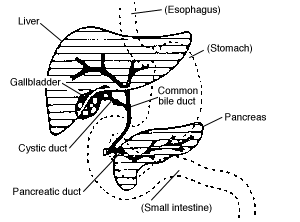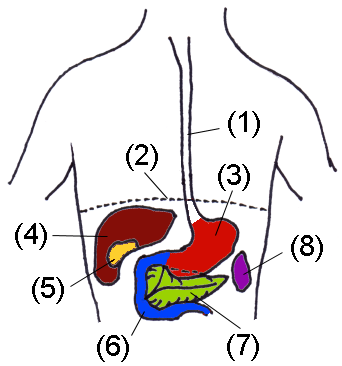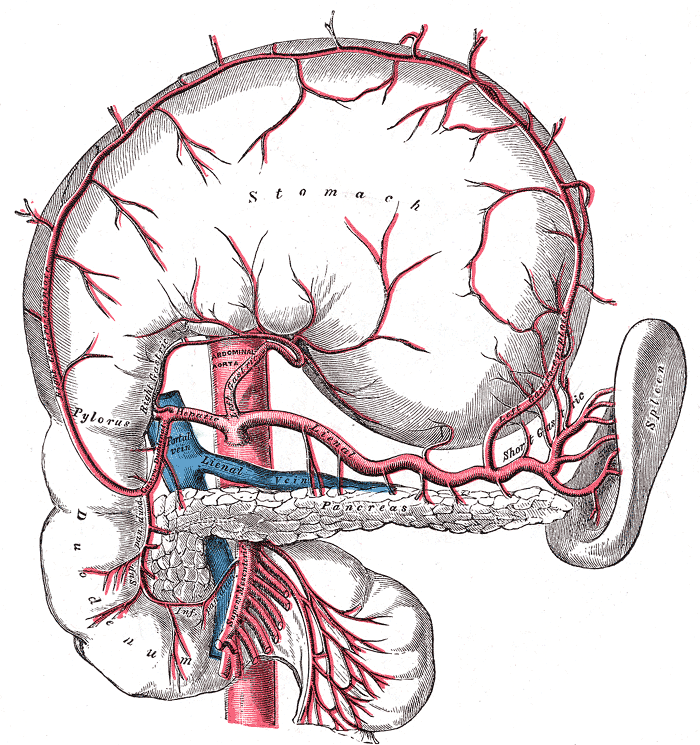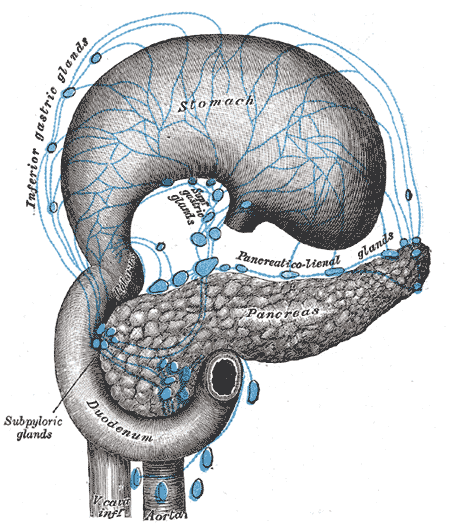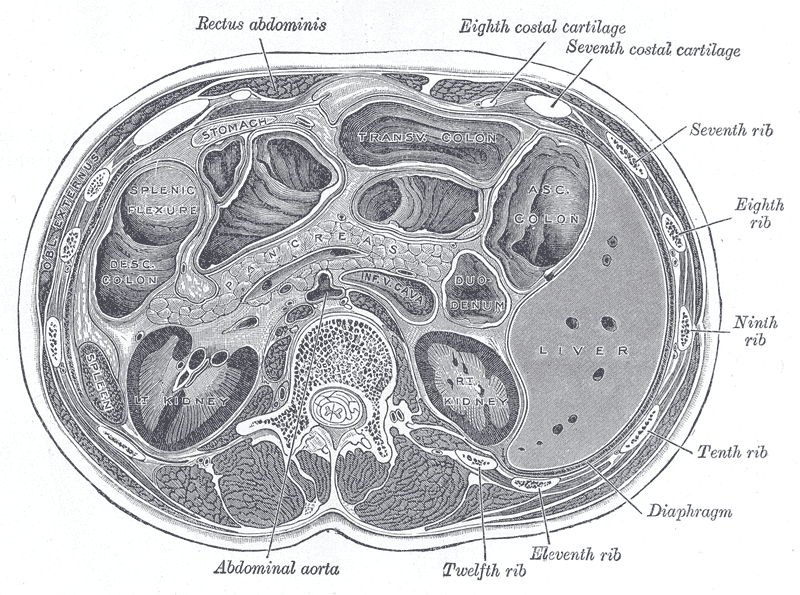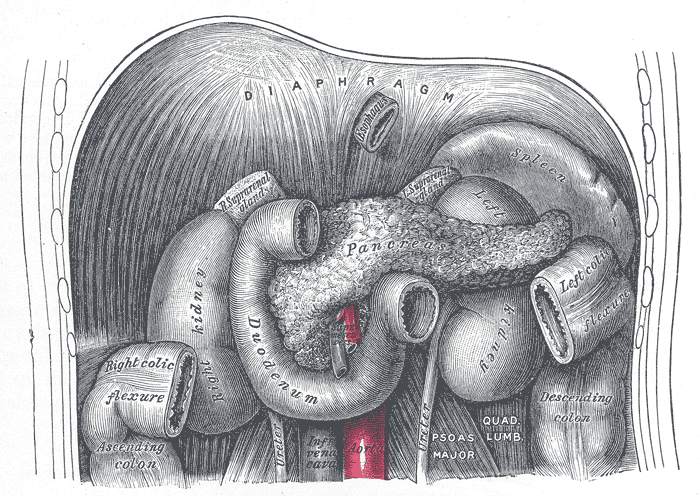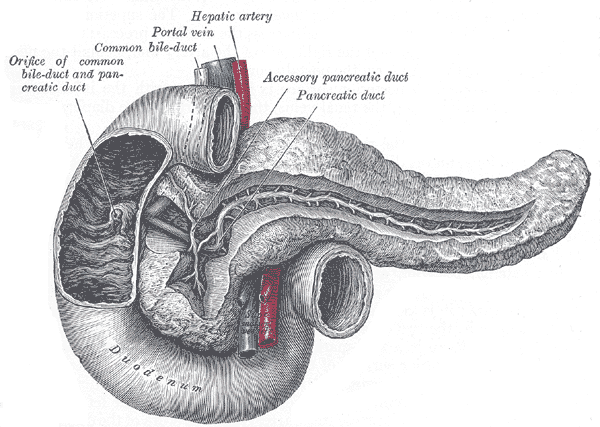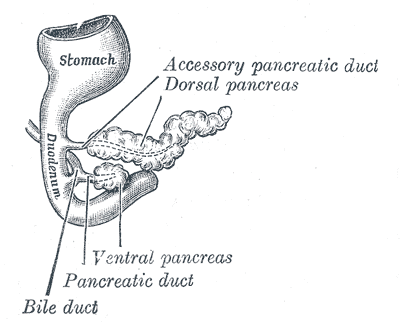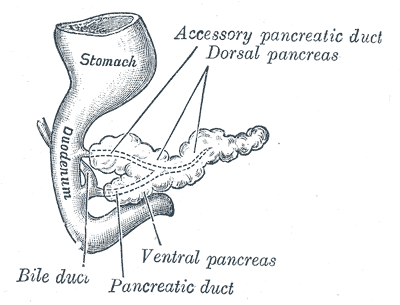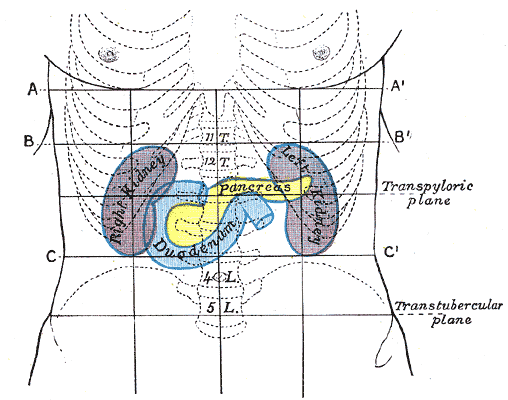Pancreas
|
WikiDoc Resources for Pancreas |
|
Articles |
|---|
|
Most recent articles on Pancreas |
|
Media |
|
Evidence Based Medicine |
|
Clinical Trials |
|
Ongoing Trials on Pancreas at Clinical Trials.gov Clinical Trials on Pancreas at Google
|
|
Guidelines / Policies / Govt |
|
US National Guidelines Clearinghouse on Pancreas
|
|
Books |
|
News |
|
Commentary |
|
Definitions |
|
Patient Resources / Community |
|
Directions to Hospitals Treating Pancreas Risk calculators and risk factors for Pancreas
|
|
Healthcare Provider Resources |
|
Causes & Risk Factors for Pancreas |
|
Continuing Medical Education (CME) |
|
International |
|
|
|
Business |
|
Experimental / Informatics |
Editor-In-Chief: C. Michael Gibson, M.S., M.D. [1]
Overview
The pancreas is a gland organ in the digestive and endocrine systems of vertebrates. It is both exocrine (secreting pancreatic juice containing digestive enzymes) and endocrine (producing several important hormones, including insulin, glucagon, and somatostatin).
Function
Under a microscope, when properly stained, it is easy to distinguish two different tissue types in the pancreas.[1] These regions correspond to the main pancreatic functions:
| Appearance | Region | Function |
| light staining circles (islets of Langerhans) | endocrine pancreas | secretes hormones that regulate blood glucose levels |
| darker surrounding tissue | exocrine pancreas | produces enzymes that break down digestible foods |
Endocrine
There are four main types of cells in the islets of Langerhans. They are relatively difficult to distinguish using standard staining techniques, but they can be classified by their secretion:
| Name of cells | Endocrine product | % of islet cells | Representative function |
| beta cells | Insulin and Amylin | 50-80% | lower blood sugar |
| alpha cells | Glucagon | 15-20% | raise blood sugar |
| delta cells | Somatostatin | 3-10% | inhibit endocrine pancreas |
| PP cells | Pancreatic polypeptide | 1% | inhibit exocrine pancreas |
The islets are a compact collection of endocrine cells arranged in clusters and cords and are crisscrossed by a dense network of capillaries. The capillaries of the islets are lined by layers of endocrine cells in direct contact with vessels, and most endocrine cells are in direct contact with blood vessels, by either cytoplasmic processes or by direct apposition. According to the volume The Body, by Alan E. Nourse, in the Time-Life Science Library Series, the islets are "busily manufacturing their hormone and generally disregarding the pancreatic cells all around them, as though they were located in some completely different part of the body." (op. cit., p. 171.)
Exocrine
There are two main types of exocrine pancreatic cells, responsible for two main classes of secretions:
| Name of cells | Exocrine secretion | Primary signal |
| Centroacinar cells | bicarbonate ions | Secretin |
| Basophilic cells | digestive enzymes (pancreatic amylase, Pancreatic lipase, trypsinogen, chymotrypsinogen, etc.) |
CCK |
Diseases of the pancreas
Due to the importance of its enzyme contents, injury to the pancreas is potentially very dangerous. A puncture of the pancreas generally requires prompt and experienced medical intervention.
Diseases associated with the pancreas include:
Diabetes mellitus
Diabetes mellitus is a metabolic disorder characterized by hyperglycemia. All three forms of the disease are due to the inability of the beta cells of the pancreas to produce sufficient insulin.
Researchers at the Toronto Hospital for Sick Children injected capsaicin into NOD mice (Non-obese diabetic mice, a strain that is genetically predisposed to develop the equivalent of diabetes mellitus type 1) to kill the pancreatic sensory nerves. This treatment reduced the development of diabetes mellitus in these mice by 80%, suggesting a link between neuropeptides and the development of diabetes. When the researchers injected the pancreas of the diabetic mice with sensory neuropeptide (sP), they were cured of the diabetes for as long as 4 months. Also, insulin resistance (characteristic of diabetes mellitus type 2) was reduced.
Benign tumours
Like any other organ, the pancreas is susceptible to the growth of benign tumors. Benign tumors do not invade neighboring tissues, do not cause metastases, and usually do not return after surgical removal.
It is also possible to get cancer of the pancreas which is a cancer with a particularly poor prognosis, rarely detected in its early stages.
Cystic fibrosis
Cystic fibrosis, also known as mucoviscidosis, is a hereditary disease that affects the entire body, causing progressive disability and early death. There is no cure for cystic fibrosis, and most affected individuals die young from lung failure. Cystic fibrosis is caused by a mutation in a gene called the cystic fibrosis transmembrane conductance regulator (CFTR). The product of this gene helps create sweat, digestive juices, and mucus. Although most people without CF have two working copies of the CFTR gene, only one is needed to prevent cystic fibrosis. Cystic fibrosis develops when neither gene works normally. Therefore, it is considered an autosomal recessive disease. The name cystic fibrosis refers to the characteristic 'fibrosis' (tissue scarring) and cyst formation within the pancreas. Cystic fibrosis causes irreversible damage to the pancreas, which often results in painful inflammation (pancreatitis).
Exocrine pancreatic insufficiency
Exocrine pancreatic insufficiency (EPI) is the inability to properly digest food due to a lack of digestive enzymes made by the pancreas. EPI is found in humans afflicted with cystic fibrosis. It is caused by a progressive loss of the pancreatic cells that make digestive enzymes. Chronic pancreatitis is the most common cause of EPI in humans. Loss of digestive enzymes leads to maldigestion and malabsorption of nutrients.
Hemosuccus pancreaticus
Hemosuccus pancreaticus, also known as pseudohematobilia or Wirsungorrhage, is a rare cause of hemorrhage in the gastrointestinal tract. It is caused by a bleeding source in the pancreas, pancreatic duct, or structures adjacent to the pancreas, such as the splenic artery, that bleed into the pancreatic duct. Patients with hemosuccus may develop symptoms of gastrointestinal hemorrhage, such as blood in the stools, maroon stools, or melena. They may also develop abdominal pain. Hemosuccus pancreaticus is associated with pancreatitis, pancreatic cancer and aneurysms of the splenic artery. Angiography may be used to treat hemosuccus pancreaticus, where the celiac axis is injected to determine the blood vessel that is bleeding, because embolization of the end vessel may terminate the hemorrhage. Alternatively, a distal pancreatectomy may be required to stop the hemorrhage.
Pancreatitis
Pancreatitis is inflammation of the pancreas. There are two forms of pancreatitis, which are different in causes and symptoms, and require different treatment:
- Acute pancreatitis: A rapidly-onset inflammation of the pancreas.
- Chronic pancreatitis: A long-standing inflammation of the pancreas.
Pancreatic pseudocyst
A pancreatic pseudocyst is a circumscribed collection of fluid rich in amylase and other pancreatic enzymes, blood and necrotic tissue, typically located in the lesser sac.
History
The pancreas was first identified by Herophilus (335-280 BC), a Greek anatomist and surgeon. Only a few hundred years later, Ruphos, another Greek anatomist, gave the pancreas its name. The term "pancreas" is derived from the Greek pan, "all", and kreas, "flesh", probably referring to the organ's homogeneous appearance.[2]
Pancreas as a food
Pancreases (specifically calf and lamb pancreases) are eaten in meals like Sweetbread, often going by the name stomach.
Development
The pancreas forms from the endoderm. The endoderm is responsible for the production of the tissue within the pancreas, lungs, and thyroids. The pancreas starts to form in the tenth week in fetal development. In the twelfth week the islets of Langerhan start to show. The pancreas is fully matured by the age of two. Therefore, infants show digestive problems due to the fact that their pancreas is unable to secrete all of the proper digestive enzymes.
Additional images
-
Accessory digestive system.
-
Digestive organs.
-
The celiac artery and its branches; the stomach has been raised and the peritoneum removed.
-
Lymphatics of stomach, etc. The stomach has been turned upward.
-
Transverse section through the middle of the first lumbar vertebra, showing the relations of the pancreas.
-
The duodenum and pancreas.
-
The pancreatic duct.
-
Pancreas of a human embryo of five weeks.
-
Pancreas of a human embryo at end of sixth week.
-
Front of abdomen, showing surface markings for duodenum, pancreas, and kidneys.
References
- ↑ Histology image: 10404loa – Histology Learning System at Boston University
- ↑ Harper, Douglas. "Pancreas". Online Etymology Dictionary.
Template:Digestive glands
Template:Endocrine pancreas
Template:Gastroenterology
af:Pankreas ar:بنكرياس bn:অগ্ন্যাশয় bs:Gušterača bg:Панкреас ca:Pàncrees cs:Slinivka břišní (člověk) da:Bugspytkirtlen de:Pankreas eo:Pankreato eu:Pankrea gl:Páncreas hr:Gušterača id:Pankreas it:Pancreas he:לבלב ku:Pankreas la:Pancreas lt:Kasa hu:Hasnyálmirigy mk:Панкреас nl:Alvleesklier no:Bukspyttkjertelen nn:Bukspyttkjertelen sq:Pankreasi simple:Pancreas sk:Podžalúdková žľaza sl:Trebušna slinavka sr:Гуштерача fi:Haima sv:Bukspottkörtel ta:கணையம் yi:קישקע
